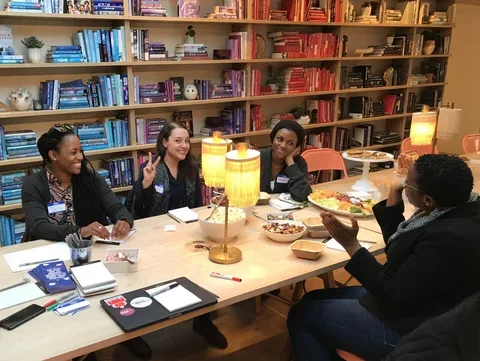Working with multifaceted and diverse teams to solve complex issues is a part of everyday life at Lullabot. Therefore, becoming stronger, more empathetic communicators who foster diversity, equity, and inclusion (DEI) across the organization is something we’re striving for continuously. That said, DEI is a tough nut to crack, and we’re a work in progress. Like many organizations, we’re constantly asking ourselves, “How do we better foster a sense of inclusion and allow for different types of people, with varied abilities and skills, to work together to solve problems for the future?”
A group that has the benefit of an inclusive environment will:
- be more agile and culturally competent, and
- be able to work with a variety of viewpoints, carefully considered, toward building a more thoughtful, and hopefully better, end product or service.
We're learning how to improve internal communication and hold space for each other as we dive into these types of conversations. This series is a compilation of some tips we’ve collected through our continuing work, and we encourage you to share your own.
Make a Plan to Foster Inclusion
While we consider ways to build up teammates and their sense of belonging in the job, we also desire each individual’s highest and best level of participation in a shared mission. Our team, as well as other knowledge workers, are becoming increasingly aware of the ability to leverage the extreme potential and power of technology to expand ideas, increase access to opportunities, and level the playing field.
Be Explicit
If an organization does not have a policy publicly stated, proactively, in the marketplace, others may have already crafted a narrative about mission and values without management’s participation. Be explicit about where the company stands. Make clear what’s important to the company, both internally and externally. We share our Mission and Core Values on our website and encourage clients and job applicants to review them, and are continuously finding ways of infusing these into our workflows and culture to ensure our team is living up to these ideas.
Start Now and Build into the Schedule
Who represents, guides, leads, and makes decisions for the company? Take a picture of the board or staff—who’s in the photo? Evaluate who’s who and identify whose voices the organization has chosen to elevate, increase, and honor.
- Are voices missing? If so, why?
- What opportunities exist for all staff to increase their skills and advance?
- What opportunities exist for people traditionally excluded from work?
- In which ways may new people participate as staff, interns, apprentices, consultants, or vendors?
- For any of the above, what’s the tracking mechanism? Free and low-cost tools exist to help you collect, analyze, report on, and share data to help with decision-making.
- Is there a transparent way to demonstrate how staff may advance, either within their career track or if they'd like to switch to a different path such as management or sales?
- Whose voice is missing? Who is not in the room? Representation matters.
Incorporate Inclusion as a Guiding Value, and Put It into Practice
While it’s great to have ideas, implementing them is some of the most difficult and demanding work. It’s best to start where you are and incrementally improve.
Consider determining three tasks to implement in the next quarter to increase the types of voices you currently have represented, and evaluate every 8-12 weeks how you’re doing, what’s working, what’s not working, and where you want to invest strategically. The Drupal Diversity and Inclusion group offers weekly accountability, support, and connections on initiatives across the Drupal community. Internally, our newly-formed Inclusion and Equity working group is discussing governance, goals, and how to move forward with our efforts toward greater inclusion.
Respect Autonomy
The best work does not always happen in an assigned cubicle, hot desk, or office. An individual might be better suited to doing focus work in the morning, taking a siesta break, then picking up again after dinner and going to midnight. Some of our teammates need to make day-by-day, non-scheduled arrangements for childcare, eldercare, medical appointments, and other issues, and much unpaid labor falls on stay-at-home workers. When a new team member requests to be on-call for a specific block of time, how does a company make it work? A flexible schedule (learn about my colleague Sean Lange’s routine while working from home) allows our teammates to more equitably participate in the workforce and bring their best ideas to us when they’re ready to do so.
Respect staff’s autonomy and ability to choose and set their hours, and encourage a culture of high expectations as well as high performance. Clearly define deliverables and the practicalities of team needs (such as deadlines for when certain projects need to launch), but allow the team to determine the best way for them to deliver, rather than forcing people to adhere to an inflexible work arrangement where they clock in and immediately tune out.
Practically speaking, workforce trends for remote work are increasing: 26 million employed persons worked at home on an average day in 2018 (Bureau of Labor Statistics), and there are increasing numbers of positions that offer telework, telecommuting, and work-from-home options. Generation Z, which is predicted to become 36% of the global workforce in 2020, is comfortable with technology to make conferences, meetings, and training sessions seamless regardless of location.
We’re a 100% distributed company, where all workers are remote, and there is no centralized office. As everyone works across multiple time zones, we’ve continually experimented with practices that foster community and connection. Read more about being a distributed company. Based on client desires and existing systems, we use Zoom, Uberconference, Google Meet, Webex, and Slack, among others, for conferences.
Support Mental Health and Wellness
The bulk of staff time is spent in the workplace or doing work-related activities. Burnout, stress, depression, anxiety, and mental health disorders directly impact teammates, colleagues, and clients. The American Institute of Stress survey shows 40% of workers reporting that their job is “very or extremely stressful” and 80% of workers report feeling stress on the job (with almost half saying they “need help in learning how to manage stress”). Lost productivity resulting from depression and anxiety is estimated to cost the global economy US$ 1 trillion each year, according to the World Health Organization.
Over the last year, we have made mental health a priority: learn more about Supporting Mental Health at Lullabot. Three best practices to support reducing stress and increasing mental health at the workplace include:
1) Avoid overscheduling your team: offer flexible work arrangements. For example, we work a 30-hour billable week and have 10 additional hours for contributing back to the company and community.
2) Create an open and relaxed work environment with access to management and ongoing feedback loops. For example, we use the Know Your Team tool (podcast) to organize constructive one-on-ones. Other activities, including scheduled coffee talks for drop-in support and advice, a weekly team call, small group calls on Fridays, a town hall with leadership every month, multiple Slack channels for conversations ranging from #being-human to #cats to #parenting, and a back-end “Daily Report” for internal news and reports.
3) Increase education. For example, offer access to mental health and general health and wellness topics, and provide training and development opportunities. With continuing education and professional skill-building, teams have documentable ways to increase productivity and overall experience.
Mental health awareness means implementing actions small and large across the organization that include:
- Scheduling breaks in long meetings.
- Obtaining psychotherapy, counseling, grief support, and similar add-ons to the health package.
- Scheduling monthly or quarterly gatherings to discuss or practice mental health wellness.
- Offering paid time off.
Invest in Personal and Professional Development, Training, and Education
“What happens if we train them, and they leave? What happens if we don’t, and they stay?”
While salary and benefits remain the base of any job, investment in an employee’s unique talents also pays off. Consider investing in professional development, training, certification, and other educational hours through an annual allocation or a pooled budget for staff-directed or individually-planned training. As part of our benefits package, we each receive an education and event budget annually. This may take the form of an education budget used for conferences, seminars, training, and continuing education. Determine a process for staff to propose options and receive feedback or vetting, perhaps as part of their employee review process, as they build up a multi-year plan to improve their abilities.
Required To-Do List, Start Here
Make software, website, and digital products accessible
In web development, making digital properties as accessible as possible is required and best practice (check the a11y project). Technical Account Manager at Lullabot, Helena McCabe’s presentations give excellent tips on how to enable accessibility. By starting with an emphasis on accessibility for the digital property, additional issues around inclusion, culture, the role of technology, and overall trends in society may begin to surface. Our white paper on How Accessibility Protects your Business and your Bottom Line offers examples on how to make your products accessible and why it matters.
Practice transparency
Think of transparency as a way to build the team’s muscles, and to start working with fortitude, grace, and strength when grappling with heavier and more complex issues. For example, we practice open-book management (OBM), a financial practice that allows all employees to understand the current revenue, expenditures, and KPIs of the company (learn more at CEO Matt Westgate’s 2019 Lullabot Team Retreat post). By creating the flexibility and capacity to have tough discussions, everyone may use a shared language and understanding of the company’s direction.
Promote a sense of psychological safety
The open-source movement continues to build on information freely shared, vetted, and evaluated across multiple use cases. The belief in sharing knowledge is in the DNA of companies like ours. In our case, Drupal is the community and platform on which many of the staff have built their careers.
Psychological safety is the bedrock for knowledge-sharing: it’s "a condition in which you feel (1) included, (2) safe to learn, (3) safe to contribute, and (4) safe to challenge the status quo—all without fear of being embarrassed, marginalized or punished in some way." (Timothy R Clark, 2019). And, it’s something to which Lullabot aspires: here’s a link to Matt Westgate’s lightning talk on psychological safety and DevOps.
With accessibility, transparency, and safety in mind, we'll share more tips to begin or advance discussions around: hiring inclusively, engaging with staff, focusing on culture, and easier fixes. As we continue to work on this internally, we offer these ideas in the spirit of sharing and continuous improvement. Do you have ideas? Please drop a comment. We'd love to hear your thoughts and suggestions.


